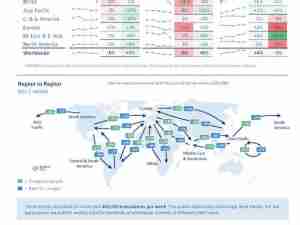Pneumatic Tubes, Paper Tickets Make Last Gasp at Southwest
By: | Mar 15 2017 at 12:50 PM | Air Cargo
The pneumatic tubes and paper tickets have got to go.
In its 45 years of flying, Southwest Airlines Co. has been known for its lean operations and vaunted “20-minute turns”—the time between a jet getting to a terminal and pulling away for the next flight. The airline’s low-cost, no-frills, single-model fleet and mostly direct service meant Southwest didn’t need the tablet-toting mechanics, bag scanners for ramp workers and other technological advances that swept the industry.
That’s about to change as the airline says goodbye to its antiquated systems. Southwest is spending as much as $300 million to bring new technology to the airport ramp and other operations. That adds to the $500 million the airline has devoted to a new reservation system—the airline’s biggest tech update ever. Southwest expects to recoup its investments by 2020.
“We’re looking for minutes,” Chief Operating Officer Mike Van de Ven said in an interview. “How do I save a minute here, a minute there? In 2017, we are more deliberate in our continuous improvement efforts.”
Those efforts have become more critical over the past five years as Southwest has acquired another airline, begun flying larger planes, started overseas flights, built international terminals and expanded service at its home airfield in Dallas. The changes have added complexity, doubling the carrier’s turns to a costly 40 minutes. And this year, Southwest will add $700 million in expenses from two new labor contracts and a third under negotiation, according to a JPMorgan Chase & Co. estimate.
“Southwest’s approach was so successful for so long that it has taken them time to recognize where there’s room for improvement,” said Samuel Engel, aviation vice president at consulting firm ICF International. “Sometimes you look back and realize, ‘There have been innovations and we need to catch up.’” Southwest has been the second-best stock in the Dow Jones Transportation Average, and the best airline, with a 44 percent gain for the six months through Tuesday.
Reservation System
The new domestic reservation system will replace 30-year-old technology this year, giving Southwest the same ability as rivals to accept foreign currency, recover faster from storms, and more easily change prices and schedules. Southwest also will be able to tighten the timing of flights for connecting passengers, which have increased 11 percent since 2012.
On the tarmac, mechanics and other workers will get tablets that receive real-time information so they can start addressing problems in the first five minutes of an aircraft’s turn. Other tools will let Southwest better match airport staffing to flight-schedule changes.
No longer will ramp personnel have to use pneumatic tubes—a technology that preceded the Wright Brothers’ first flight by about 50 years—to send notes in canisters about luggage and other cargo to workers who calculate critical jet weight and balance and carry the data back to the plane. Instead, the information will be sent electronically. Digital transmissions also will replace printouts for personnel who transport bags to and from planes. The upgrades will start rolling out this year, with more improvements through 2020, when they are expected to boost earnings about $100 million a year.
‘Added Complexities’
“We’re pretty manual on the ramp,” Van de Ven said. “We have great capabilities, but added complexities. We have to be able to manage through them better.”
New technology had received a lower priority than initiatives like acquiring low-cost rival AirTran Airways in 2010, which put Southwest in Atlanta. The airline then turned to revamping its international and domestic reservation system before upgrading operations.
“It does add up over time,” said Savanthi Syth, a Raymond James Financial Inc. analyst. “It gives them scalability for future service. Southwest is definitely, more and more every day, looking more like a network carrier.”
The upgrades will give Southwest additional information to identify bottlenecks in getting passengers on and off planes. The airline already has added an exit stairway from the rear door to the tarmac on some jets. The procedure, in place at 13 airports, isn’t used at particularly congested cities or when the weather is bad.
Paper Tickets
And in May, the new reservation system will allow Southwest to get rid of its last paper tickets by issuing electronic versions to people traveling on employee guest passes. While the travel currently is booked online, the passengers need paper tickets, an irritating expense for transactions that don’t generate revenue. The carrier issued about 300,000 of the passes last year.
In some ways, Southwest has been a victim of its own success. Its longer aircraft turnarounds in part came as the carrier added the Boeing Co. 737-800, the airline’s largest plane, to its 737-only fleet. The carrier also has begun traveling farther, flying fewer empty seats and, unlike many rivals, not charging for as many as two checked bags. Such factors mean more luggage on planes, increasing loading and unloading times.
“To be real blunt, up until about 2010 it all worked pretty well,” Van de Ven said, describing Southwest’s old-school ramp operations. “We had a fantastic run in terms of low costs, given the technical infrastructure we had, and we’re at that point that we need to make some investments.”
